
eyebrow piercings are usually placed on the outside third of the brow. They are surface piercings, which means they go through a flat piece of skin rather than a flap like an earlobe. With proper aftercare, your piercing should heal in two to four months, at which time you can change your jewelry.
Eyebrow Piercing Procedure
A professional piercer marks a dot above and below your eyebrow to indicate the entry and exit points of the needle. She cleans your skin with surgical scrub and pinches the two dots between a pair of clamps known as Pennington forceps. Using a single-use sterile needle called a cannula needle, she pierces through the two dots. As she pushes the needle out, she pushes the jewelry in. You should not feel the jewelry insertion.
Eyebrow Piercing Aftercare
The Association of Professional Piercers recommends soaking new piercings twice a day in a saline solution made of 1/4 tsp. sea salt and 1 cup of warm bottled water. For facial piercings, you may wish to soak a sterile gauze pad with the solution to make a compress. After soaking for five minutes, wash your piercing with an unscented antimicrobial or antibacterial soap, which many piercing shops sell. Change your pillowcases frequently, and keep cosmetics and moisturizers away from the piercing while it is healing.
Appropriate Jewelry
The most common jewelry for eyebrow piercings is a curved barbell or captive bead ring. These are usually made of surgical stainless steel, though they can also be made of titanium, niobium or gold. Common gauges, or thicknesses, range from 18 to 12, with 12 being the thickest. The thicker your jewelry, the less chance it has of tearing through the piercing. 3/8 inch is a common length. Your piercer may use a longer bar in a curved barbell to allow for swelling. You can change your jewelry to a shorter bar after the piercing has healed.
Changing Eyebrow Jewelry
Changing a curved barbell is fairly simple. The jewelry unscrews into three pieces--the bar and the two beads. It is often easier to unscrew the top bead, insert the jewelry from below the eyebrow, and screw the top bead back into place. Captive bead rings can be a bit trickier, but at small gauges you can usually change them yourself. The bead pops out sideways and has two indentations. Seat the bottom indentation on the bottom prong, then push the bead toward the top prong until you feel the upper indentation snap into place. Lubricating your jewelry with liquid soap will make it easier to insert.
Body Piercing Risks
Piercings performed by a professional piercer trained in sterile technique usually heal well with proper aftercare. However, there is always a risk of infection, which usually results from touching your jewelry without washing your hands. If your piercing is red and swollen, it may just be irritated, which is normal. If it is hot to the touch, oozing pus or hurts when you move the jewelry, you may have an infection. If you have fever or chills, call your physician immediately.
Related Articles

How Long to Wait Before You Change a ...
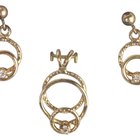
How Long After Piercing Can You Change ...

How Long Before a Nose Ring Hole Closes?

How to Remove a Labret Piercing

How to Gauge the Ears Right After the ...

How to Remove Your Nose Piercing & Put ...
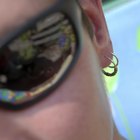
Places to Pierce Your Ear

How to Take Out a Lip Ring Stud

How to Change a Labret

How to Stretch Your Lip Piercing

How to Hide My Cheek Piercing
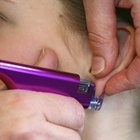
What Size Gauge Is an Ear Piercing Gun?
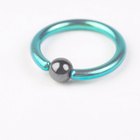
How to Clean Your New (Conch) Ear ...

What Type of Rings Can You Get When You ...

How to Put in a Captive Bead Lip Ring

How to Take Out a Cartilage Earring ...
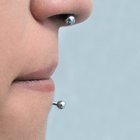
Types of Nose Rings

How to Wear a Nose Hoop

Facts on Nose Piercings

How Do They Pierce Your Ears With ...
References
Resources
Writer Bio
Ann Jones has been writing since 1998. Her short stories have been published in several anthologies. Her journalistic work can be found in major magazines and newspapers. She has a Master of Fine Arts in creative writing.
Photo Credits
naughty boy image by Frenk_Danielle Kaufmann from Fotolia.com